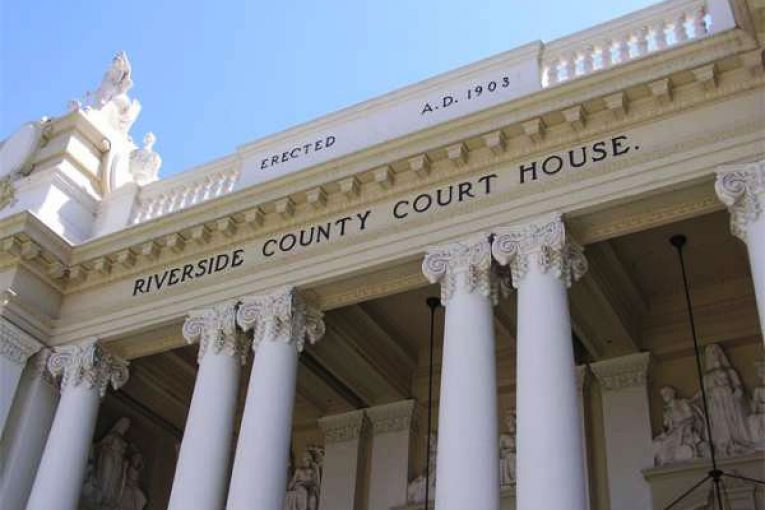

By Natalia Ruvalcaba
RIVERSIDE, CA – Testimony from two police officers was heard Monday in the ongoing trial here in Riverside County Superior Court for a trio of alleged gang members who are accused of killing a man in September of 2017.
Attorney Richard Carnero, Deputy Public Defender Solely Diallo, and Attorney A.C. Jones are the defense lawyers for the three men accused of the 2017 crime, Lonzo Lee Ford, Jevante Terrell Stewart and Dameontae Wright Patterson
Former Deputy Michael Meija, now retired, was a detective with the Riverside Sheriff’s Department. While a station-level detective, Deputy Meija was primarily assigned to sex crimes and child abuse.
Deputy Meija explained he had been at home off-duty when he received a call about a shooting and went to the scene. After the call, Deputy Meija recalled going to the station where he met with the lead homicide investigator.
According to Meija, he walked through the scene with the other detective who showed him where the evidence remained, including projectiles and casings.
Deputy Meija reported that he and the other investigator continued to look over the crime scene while they pointed out all discernible evidence. The technician at the scene would then, according to Deputy Meija, mark items they discovered or noted as evidence.
When questioned by the defense about the evidence system, Deputy Meija noted that evidence that could be photographed was numbered and anything  that could be taken was marked by a letter.
that could be taken was marked by a letter.
One by one, the attorney went through casing evidence and photograph evidence, questioning exactly what item was what, as examined by Deputy Meija. The deputy observed three 380 caliber casings and one that belonged to a 45 caliber that the attorney brought forward as evidence.
Then, the attorney presented photo evidence to Deputy Meija, asking what he examined in the image. Deputy Meija reported seeing an “entry point to the screen door by a bullet” and copper inside of the impression. When presented with evidence “32” the deputy stated that he saw the letter B that marked an impact point where the bullet hit the wall.
Deputy Meija was then asked about his prior experience with bullets and strikes. The defense attorney asked, “How many strikes have you seen?” to which Deputy Meija responded, “Hundreds.” The deputy then proceeded to say that not all bullets travel through some things, that some bullets will not even go through drywall.
When presented with evidence “34” Deputy Meija stated that the image consisted of the front of the house and a hole with the copper jacketing still inside. Evidence “36” was noted by Meija as being an image of the hole from the interior of the house.
Deputy Meija, after being questioned by the defense, explained the steps of processing evidence. As maintained by Deputy Meija, the technician gives a list of items and then books them into evidence. They don’t have a physical person retrieving evidence, rather they place all evidence into lockers that, once closed, can only be opened from the other side.
When questioned about the projectile that struck the victim, Deputy Meija responded saying that the projectile was of concern because it could not be located. The technician and Deputy Meija, according to his testimony, spent extra time looking for the projectile to no avail.
The attorney then asked, “At some point during the investigation did you know if the projectile had entered the victim?” to which the deputy responded, “I didn’t know.” Then the attorney asked, “Was it possible the projectile was still in the victim?” which Deputy Meija said, “Very possible.”
The attorney was then finished with Deputy Meija’s testimony and called Deputy Stephen Enoch to the stand. Deputy Enoch currently is a sworn police officer, who has served 16 years thus far.
The defense questioned Deputy Enoch about an assault he was called to, the day before the trio allegedly committed homicide.
On Sept. 15, 2017, Deputy Enoch reported being dispatched to a call regarding an assault with a weapon. Once arrived on the scene, the deputy made contact with a Hemet police officer. Deputy Enoch was then met by a mother, who directed the deputy to her son and another individual at the crime scene.
Deputy Enoch reported being told that the vehicle in which the son and the other individual were in was being shot at while they were inside.
The vehicle had been struck four times, including in the windshield and the front near the vehicle’s lights. Deputy Enoch asserted that he found only one projectile and that was submitted into evidence and the car was then photographed as evidence as well.
When asked by the attorney about any witnesses to the crime, Deputy Enoch reported reaching out to neighbors or asking if anyone witnessed the crime to no avail. “ No one wanted to be a witness,” reported Deputy Enoch.
The attorney then presented the deputy with an image, a booking photograph of the son who reported being shot at, as noted by the deputy. Enoch reported it was the male at the scene and that he and his mother were cooperative at the time of the crime and gave him a basic statement.
The trial will reconvene Tuesday, Nov. 30.
